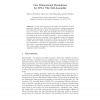Free Online Productivity Tools
i2Speak
i2Symbol
i2OCR
iTex2Img
iWeb2Print
iWeb2Shot
i2Type
iPdf2Split
iPdf2Merge
i2Bopomofo
i2Arabic
i2Style
i2Image
i2PDF
iLatex2Rtf
Sci2ools
DNA
2003
Springer
2003
Springer
One Dimensional Boundaries for DNA Tile Self-Assembly
In this paper we report the design and synthesis of DNA molecules (referred to as DNA tiles) with specific binding interactions that guide self-assembly to make one-dimensional assemblies shaped as lines, V’s and X’s. These DNA tile assemblies have been visualized by atomic force microscopy. The highly-variable distribution of shapes – e.g., the length of the arms of X-shaped assemblies – gives us insight into how the assembly process is occurring. Using stochastic models that simulate addition and dissociation of each type of DNA tile, as well as simplified models that more cleanly examine the generic phenomena, we dissect the contribution of accretion vs aggregation, reversible vs irreversible and seeded vs unseeded assumptions for describing the growth processes. The results suggest strategies for controlling self-assembly to make more uniformly-shaped assemblies.
Related Content
| Added | 06 Jul 2010 |
| Updated | 06 Jul 2010 |
| Type | Conference |
| Year | 2003 |
| Where | DNA |
| Authors | Rebecca Schulman, Shaun Lee, Nick Papadakis, Erik Winfree |
Comments (0)

